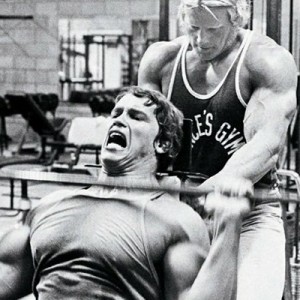The short answer to this is “no, you should not train to failure.”
Or at least, you shouldn’t train to failure on a frequent basis.
Training to failure – despite what’s commonly purported in most fitness magazines – will NOT help you get stronger.
In fact, training to failure on a regular basis can actually make you weaker, and this comes down to the fact that it reduces confidence, and it generates an insane amount of fatigue that becomes increasingly harder to recover from.
Missing Lifts and Confidence DON’T Go Hand in Hand
If you’re training to failure, you’re missing lifts.
After all, if you fail, it means you failed with a weight before you hit your target number of repetitions (if a set is extremely hard yet you still hit your target number of repetitions, you didn’t fail, you just trained near your max).
Missing lifts – although not harmful if done on an EXTREMELY infrequent basis – destroys your level of confidence, and seeing how confidence is directly tied to force production (and your ability to make subsequently heavier lifts moving forward) this becomes a serious problem.
Ideally, you don’t want to miss any lifts. Ever.
But, that isn’t really realistic, so I would say – at MAX – be content with missing lifts 5-10% of your total training time.
Is it gonna kill if you if you go over this recommendation?
Yes No, probably not.
But, just remember that where missing lifts destroys confidence, making lifts builds it.
And the more confident you are in your ability to lift subsequently heavier weights moving forward, the stronger you’re going to get.
Fatigue: It Will Destroy You
Ok, so maybe the subtitle is a bit of an exaggeration.
Fatigue won’t destroy you, but it most certainly can destroy your training results.
As I’ve mentioned before, fatigue effectively “masks” performance, and the goal of a well-structured training plan is to maximize performance while simultaneously minimizing fatigue.
Training to failure?
It generates a S*** TON of fatigue.
And this fatigue affects the training sessions for the rest of the week.
Which affects the training sessions for the rest of the month.
Which affects the training sessions for the rest of the year.
Which, if left unchecked, can lead to a subtle – and maybe even drastic – drop in overall strength and performance.
Remember, you want fatigue accumulation to be as low as possible, and you do this by training with submaximal weights, or by leaving 1-2 reps in the tank on all exercises.
Of course, pushing yourself is still important (absolutely critical), and you won’t make progress if you don’t continue to do more work (loads/reps/sets) over time.
However, you make progress by following a solid progression scheme.
Not by killing yourself every training session and hoping – by some happenstance – you get stronger.
Ok, Well is There Any Benefit to Training to Failure?
Of course there is.
It pushes you past your comfort zone, and stimulates new growth.
It illuminates weak points that need to be addressed in order for you to continue making progress.
It’s a powerful tool to stimulate hypertrophy, or muscle growth (bodybuilders can probably train to failure more frequently than powerlifters).
And it builds mental toughness, which is a huge part of long-term growth and success.
Although I stand by the recommendations I’ve made in this article so far, I want to make it clear that I’m NOT trying to make you afraid of training to failure, nor am I trying to make you think training to failure in and of itself is a bad thing.
ANYTHING in excess will cause problems, and most people simply abuse training to failure to the point that it starts to negatively impact their results.
However, if you don’t abuse it, training to failure can be a huge stimulus that propels you to higher levels of strength and performance.
Just remember though, training to failure – for the most part – is a TEST of strength.
And like the great Chad Wesley Smith says, “you want to build strength, not test it.”
Like What You See?
Get the Smoot Fitness Guide to Getting Stronger - FREE.



Leave a Reply